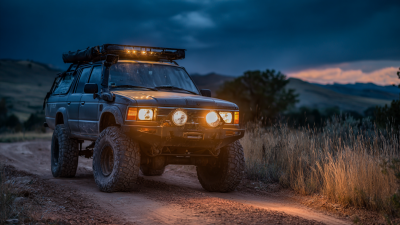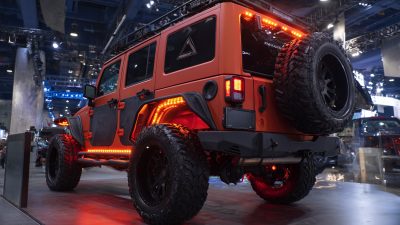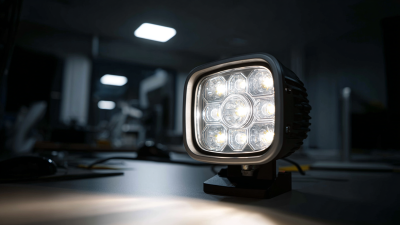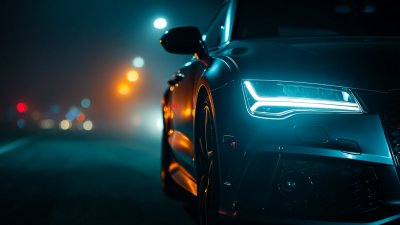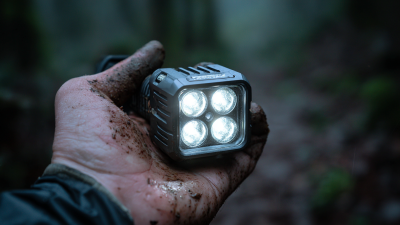Leave Your Message
When it comes to enhancing the performance and safety of your adventure vehicle, choosing the right lights for off road activities is crucial. According to a report by the Specialty Equipment Market Association (SEMA), the off-road lighting segment has seen a remarkable growth rate of over 15% annually, driven by an increasing number of outdoor enthusiasts seeking advanced lighting solutions for improved visibility during night-time excursions.
Additionally, a survey by Outdoor Industry Association indicates that nearly 65% of off-road vehicle owners consider proper lighting essential for their adventures. With a multitude of options available, from LED light bars to spotlights, understanding the key features and requirements for your specific off-roading needs can greatly enhance your off-road experience.
This ultimate guide aims to provide you with comprehensive insights to ensure you select the best lights for off road that not only meet your adventure demands but also elevate your overall driving safety and joy.

When it comes to off-road adventures, having the right lighting can make all the difference in ensuring safety and visibility. Off-road lights come in various types, such as LEDs, halogens, and HID lights, each offering unique benefits that cater to different terrains and conditions. LED lights are particularly popular due to their energy efficiency and longevity, while halogen lights provide a bright, warm glow, making them suitable for various outdoor activities. Understanding the specific features of each type is essential in selecting the optimal lighting setup for your adventure vehicle.
In addition to bulb types, beam patterns significantly influence off-road lighting effectiveness. Spot beams illuminate a concentrated area far ahead, ideal for high-speed travel on open trails. Conversely, flood beams cast a wide light, perfect for navigating tight or uneven paths. Many off-road lights now incorporate advanced technologies like adaptive lighting systems, which adjust the beam direction based on steering input, enhancing visibility around corners. Incorporating these key features and technologies into your off-road lighting choices will not only improve your experience but also increase safety during your explorations.
When it comes to off-road lighting, three primary types are commonly considered: LED, Halogen, and HID. Each option has its advantages and disadvantages, making it essential for adventurers to understand which best suits their needs. LED lights are favored for their energy efficiency and longevity. They produce bright, white light and require minimal power, allowing for extended use without draining the vehicle’s battery. Notably, LEDs are also more durable, withstanding harsh conditions typical of off-road environments.
On the other hand, Halogen lights, while less efficient than LEDs, have a warmer light that some users prefer. They are generally less expensive and easier to replace, but they generate more heat and consume more energy, potentially limiting their usage during long trips. Finally, High-Intensity Discharge (HID) lights offer intense brightness and excellent visibility, often outperforming both LED and Halogen options when it comes to light output. However, they can be more complex to install and may require specific wiring modifications. Each type of light presents unique characteristics, and understanding their differences can greatly enhance your off-road adventures.

When choosing off-road lights for your adventure vehicle, understanding lumens is crucial. Lumens measure the total amount of visible light emitted by a source, helping you determine how bright your lights need to be. For general off-road adventures, 2,000 to 5,000 lumens typically provide ample brightness for most scenarios, illuminating rugged terrains and ensuring safe navigation. For extreme conditions, such as deep trails or low visibility environments, lights exceeding 6,000 lumens can be essential.

Tips: Always consider the beam pattern alongside lumens. A wider flood beam is excellent for illuminating broader areas, while a focused spot beam can enhance visibility at longer distances. Additionally, choose lights with adjustable brightness settings, which allow you to conserve battery life in less demanding situations.
Taking into account brightness, battery life, and comfort is critical when selecting off-road lights. Modern models are designed with advanced LED technology that not only offers superior illumination but also features impressive battery longevity. A quality off-road light should ensure durability and resilience against harsh environmental conditions, making your adventures safer and more enjoyable.
When choosing off-road lights for your adventure vehicle, understanding beam patterns is crucial for optimal visibility. The three primary types of beam patterns are spot, flood, and combo lights. Spot lights offer a narrow, focused beam that allows you to see far down the trail, making them ideal for high-speed driving in dark conditions. Their concentrated output illuminates distant objects, which is essential when navigating challenging terrains.
Flood lights, on the other hand, provide a wider beam that illuminates a broader area directly in front of your vehicle. These lights are perfect for slower speeds and low-light situations, where you need to be aware of your immediate surroundings. Flood lights excel in reducing blind spots, giving you a clear view of obstacles just off the beaten path.
**Tips:** When selecting your off-road lights, consider the terrain you’ll be tackling and your driving speed. A combination of both spot and flood lights can offer the best of both worlds, ensuring safety and visibility in various conditions. Always opt for high-quality materials that can withstand the rigors of off-road adventures, and ensure your lighting setup is properly aimed to avoid blinding other drivers. Additionally, test your lights in a controlled environment to fine-tune their positioning.
This chart compares the visibility range of different types of off-road lights: Spot, Flood, and Combo lights. Spot lights provide the greatest visibility range, while flood lights are designed for close-range illumination.
When installing off-road lighting systems, safety and proper setup are paramount. Begin by selecting a suitable location for your lights, ensuring they shine unobstructed and provide optimal visibility without blinding oncoming traffic. Mount the lights securely using high-quality brackets and ensure that all wiring is protected from moisture and abrasion. It’s essential to use weatherproof connectors to prevent electrical failures during your off-road adventures.
Next, pay attention to the electrical components of your lighting system. Carefully read the manufacturer's installation instructions and follow them to the letter. Make sure to fuse your lights appropriately to avoid any risk of overload. If your vehicle has a lot of electronic devices, consider installing a relay to manage the power supply more efficiently. Lastly, it’s wise to test your setup in a controlled environment before hitting the trails, ensuring that all lights function correctly and that your installation adheres to any local legal requirements for off-road lighting. These steps will ensure a safe and enjoyable experience while exploring off the beaten path.
